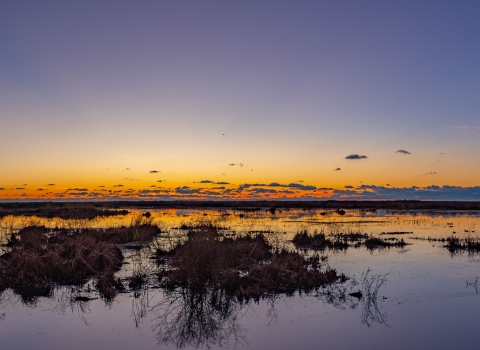The U.S. Fish and Wildlife Service is downlisting the beach layia from endangered to threatened under the Endangered Species Act (ESA) due to substantial improvements in the species’ status since listing in 1992. As a result of years of collective conservation efforts of federal, state, local and private partners, this species is one step closer to full recovery.
Beach layia is a succulent annual herb belonging to the sunflower family. The plant grows on dry, exposed beach sites spread across six isolated dune systems in coastal California. From north to south, there are 13 populations of beach layia from Humboldt County to Vandenberg Space Force Base in Santa Barbara County.
“Today’s action is the result of the collaborative conservation efforts of many partners, including federal, state, local and private groups,” said Tanya Sommer, Field Supervisor of the Arcata Fish and Wildlife Office. “While there is still work to be done before the beach layia is fully recovered, with the continued commitment of these partners and the public I am sure we will get there.”
Working together and inspired by the ESA, partners have reduced the impacts to the plant from off-road vehicle use, grazing and development throughout much of the species’ range, while restoring and protecting habitat. The beach layia remains listed as threatened under the ESA due to ongoing threats to its long-term survival, including habitat degradation, sea level rise, invasive species invasive species
An invasive species is any plant or animal that has spread or been introduced into a new area where they are, or could, cause harm to the environment, economy, or human, animal, or plant health. Their unwelcome presence can destroy ecosystems and cost millions of dollars.
Learn more about invasive species , prolonged drought and erosion.
The Service also announced a 4(d) rule for the beach layia that prohibits activities detrimental to its conservation while allowing actions that support its recovery. Section 4(d) rules are one of the many tools under the ESA designed to support landowner conservation efforts of listed species.
The final reclassification rule is available for public view today in the Federal Register. The rule will publish in the Federal Register on March 31, 2022, at which time all documents and supporting information will be available at https://www.regulations.gov/ by searching Docket No. FWS-R8-ES-2018-0042. Images of the beach layia are available in the beach layia photo gallery.
-FWS-
The U.S. Fish and Wildlife Service works with others to conserve, protect, and enhance fish, wildlife, plants, and their habitats for the continuing benefit of the American people. For more information about our work and the people who make it happen, visit https://www.fws.gov/cno/or connect with us via Facebook, Twitter, YouTube, and Flickr.



